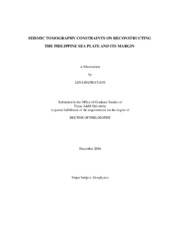| dc.description.abstract | The Philippine Sea Plate has been surrounded by subduction zones throughout Cenozoic time due to the convergence of the Eurasian, Pacific and Indian-Australian plates. Existing Philippine Sea Plate reconstructions have been made based primarily on magnetic lineations produced by seafloor spreading, rock magnetism and geology of the Philippine Sea Plate. This dissertation employs seismic tomography model to constraint the reconstruction of the Philippine Sea Plate. Recent seismic tomography studies show the distribution of high velocity anomalies in the mantle of the Western Pacific, and that they represent subducted slabs. Using these recent tomography data, distribution maps of subducted slabs in the mantle beneath and surrounding the Philippine Sea Plate have been constructed which show that the mantle anomalies can be related to the various subduction zones bounding the Philippine Sea Plate.
The high velocity mantle anomalies are clearly coincident with Wadati-Benioff zones in the upper mantle. The lower mantle anomalies, although distributed in the “transition zone” (500-1000 km) as stagnant slabs in some cases, can clearly be mapped as continuations of upper mantle subduction zones. Reconstructing the subduction of the slabs now in the mantle best fits Philippine Sea Plate reconstructions that involve the minimal or simplest rotations. Northward movement of the Philippine Sea Plate, WNW subduction of the Pacific Plate since Eocene time (~50 Ma), and northward subduction of the Indian/Australian Plate along Indonesia best explain the subducted slab mantle anomalies. The origin of the eastern plate boundary was a transform zone that evolved into a subduction zone a few million years before the Pacific Plate changed its movement. In addition, the initiation of this subduction zone might possibly be one of the triggers of the Pacific Plate motion changes.
The 90 degree rotation of the Philippine Sea Plate including southward plate subduction at its northern boundary proposed in the reconstruction by Hall (2002) is not supported by seismic tomography evidence for slab distribution in the mantle beneath the Philippine Sea region. A hypothesis of minimal rotation of the Philippine Sea Plate, supported by the seismic tomography, guides the reconstruction model presented. | en |


